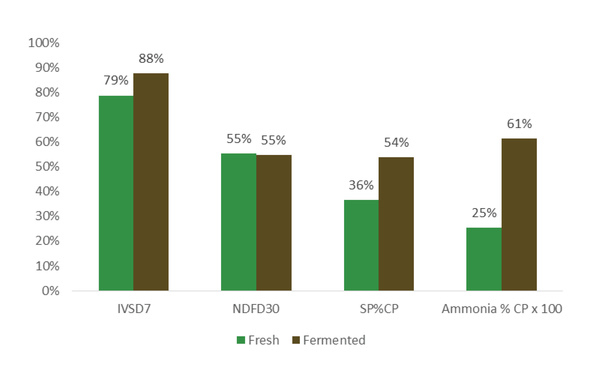Corn silage quality concerns? Add slow release nitrogen to ration
Published: October 23, 2015
Source : Ann Hess
Over the past few years, the dairy industry has made it a priority to feed higher forage diets with a correct balance of amino acids and an accurate ratio of lysine to methionine. With this strategy, there also has been more attention on the amount of undegradeable protein (RUP) being fed.
“We are feeding more high forage diets than we ever had in the past,” said Gene Goenner, territory product representative for Alltech Wisconsin. “With this feeding strategy, we also need to make sure that we don’t ignore the need and importance of rumen degradable protein (RDP) in the diet.”
According to Goenner, in high forage rations, RDP needs to be fed at an adequate level that sustains the need of rumen microbes (bugs). Fiber-digesting rumen microbes require ammonia in order to grow and break down the large amounts of cellulose being consumed in these diets, thus creating the energy needed for the cow.
However, the amount of ammonia in the rumen can vary (Agle et al., 2010. J Dairy Sci. 93:1625-1637), demonstrating a need for additional dietary non-protein nitrogen, regardless of the crude protein level of the diet.
“Fluctuation in ruminal ammonia levels is augmented by the way a cow eats with long periods between meals and different sizes of meals,” Goenner said. “It does not matter how often the animal is fed or how often feed is pushed up, rumen ammonia levels drop below desirable levels at different times in any given day.”
Since 2012, more than 44,450 corn silage samples have been submitted to Dairyland Laboratory. When broken into two groups, fresh vs. fermented corn silage, the average soluble protein percent of fresh corn silage is a full 18 percent lower, with 54 percent in the fermented samples and only 36 percent in fresh corn silage.
“Fiber digestion in the rumen in critical to maximizing feed efficiency,” Goenner said. “In order to do this the rumen needs a substantial and consistent time-released source of nitrogen.”
Many producers are now relying on the use of a non-protein nitrogen product, such as Optigen®. By providing a slow release nitrogen source, the technology can effectively supply the required levels of ammonia, especially for fiber-digesting bacteria. Unlike urea, nitrogen from slow release urea is effectively used by the rumen microbes and less ammonia is wasted or recycled, thus sparing the animal considerable amounts of energy that can be used to produce milk instead.
“A stable rumen ammonia level will enhance the overall digestion of fiber, not only now as fresh corn silage is being fed, but throughout the entire year as there is always variability in feedstuffs,” Goenner said.

Source
Ann HessRelated topics
Mentioned in this news release:
Join to be able to comment.
Once you join Engormix, you will be able to participate in all content and forums.
* Required information
Would you like to discuss another topic? Create a new post to engage with experts in the community.
Create a post





.jpg&w=3840&q=75)